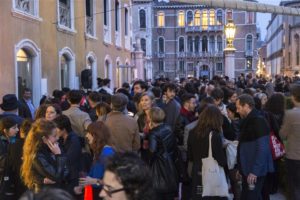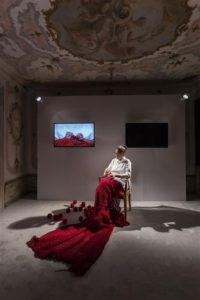Por: Lisset Alonso Compte

Cuban Art at the Venice Biennial[1]
Access to the famous Biennale, one of the most rigorous and at the same time exclusive events in the international visual arts world, has not always been easy for artists from the Third World. That is especially the case when they live in their countries of origin. However, after several years of participation, whether in the form of a national pavilion, specific invitations to artists as part of the general curatorship, in collective exhibitions, or under the umbrella of the Instituto Italo-Latinoamericano (IILA), the Cuban presence was again significant in this 57th edition.

Cuba’s first participation in Venice was in 1952. Since then, some of our most versatile creators have paraded through the City of Canals, among them: René Portocarrero, Wifredo Lam, Raúl Martínez, and Flavio Garciandía. In recent years, our country has continued strengthening its importance in the Venetian exhibition circuit, first under tutorship and support of Miria Vicini, who assumed the role of administrator of the three previous showcases, and now with Jorge A. Fernández Torres, director of the National Museum of Fine Arts and co-curator of the three previous shows, as curator of a Cuban pavilion.
The new autonomy with which Cuba faces this 57th edition offers the possibility to increase the number of guest artists to 14, which is atypical for the event, in which most countries present solo exhibits. José Manuel Noceda Fernández assumed the challenge as curator of the Cuban Pavilion.
According to Noceda, the concept of the showcase began to develop in late November 2016, after successive invitations to Jorge A. Fernández and Rubén del Valle Lantarón, then president of the Consejo Nacional de las Artes Plásticas (CNAP). He said that the work process was complex, and was characterized the whole time by a collegial methodology and active intervention; initially of Rubén del Valle Lantarón and Isabel Pérez as curatorial assistant, and later of Jorge A. Fernández, Teresa Domínguez (who subsequently assumed the presidency of CNAP), and Quique Martínez as head of Art Engineering.

Público asistente al brindis de inauguración del Pabellón cubano en la 57 Bienal de Venecia
In the design of the Cuban Pavilion, the planners took into account the Biennial’s general curatorship as well as the particularities of the context and the art produced in our country. Regarding this relationship, Noceda explained, “As I usually do when participating in an international event, I try to understand the curatorial logic that orients and guides it; I study the theoretical document that describes the general project and try to interpret its possible meanings. It is an act of respect for the ideas of the general curatorship, this time under the tutelage of Christine Macel under the title Viva Arte Viva. . . . But at the same time I do not ignore the geo-cultural context under study, trying to create a much more specific connection with it.”
This is how the idea emerged of working from one of Alejo Carpentier’s definitions of ‘temporality’ in Latin America and the Caribbean; a notion, Noceda assures, that is still fully pertinent and that he himself has applied to some studies on the art and creative processes in our region. “In one of his conferences on the novel in Latin America, early in the 1960s, the writer pointed out the coexistence of three simultaneous time-related categories: the time of the past or time of the memory; the time of the present or time of intuition and vision; and the time of the future or time of waiting.”

Susana Pilar junto a Carlos Martiel luego de su performance Mediterráneo
Following this idea, Tiempo de la intuición (Time of Intuition), the expression used as title of the exhibition, “alludes metaphorically to the country’s present, and to the reality of the art being made here, through very specific figures.” But at the same time it inserts itself in the curatorial logic of Macel, who dedicated one of the nine “trans-pavilions” that make up the Central Showcase to explore the notions of time and infinity.
However, there is a still deeper connection between the concept of the Cuban exhibition and the ideas expressed by the Biennial’s general curator. “In her approaches,” says Noceda, “Macel insists on the circumstances that define the global present in which we live (riddled with crises and conflicts), calls to recover the artist’s responsibility, defends the role of art to counteract those circumstances, and emphasizes the urgency to restore the increasingly impoverished notion of humanism.”
In turn, the selection that represents our country, in addition to the inclusion of different generations, a diversity of themes, and the multiplicity of styles that define the island’s variegated art, reflects the artists’ commitment to their context and the importance of their projects and works “in sketching a different concept of humanity, based on a multiple identity in opposition to the old notion of atavism, of unique identity (Jean Bernabé, Patrick Chamoiseau, Raphaël Confiant), that takes into consideration the intersections and sounds of all cultures.”

Esterio Segura y su Chrysler frente a la entrada del Palacio Loredan
Exhibited in Campo Santo Stefano, specifically in Loredan Palace (venue of the Venetian Institute of Sciences, Arts and Literature since 1838), one of the most frequented itineraries for the public daily touring Venice, the Cuban showcase once more had to face the peculiarities of a space far from the ideal “white cube”, and for that reason most pieces functioned as site specific. “When selecting the artists and their works, the building’s characteristics and its surroundings were well taken into consideration, i.e., thought was given to the exterior as well as to the interior, and to which artists and types of works or projects would best fit in them. That is why Híbrido de Chrysler (Chrysler Hybrid), a work by Esterio Segura from 2016, is exhibited in the square.”

Aimeé García en su performance Rewind
